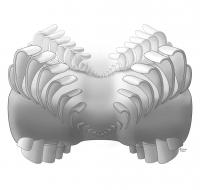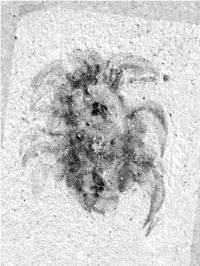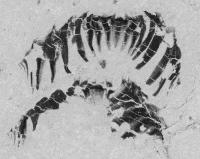
This is a reconstruction of the Odontogriphus mouthparts. The radula sounds like something from a horror movie – a conveyor belt lined with hundreds of rows of interlocking teeth. In fact, radulas are found in the mouths of most molluscs, from the giant squid to the garden snail. Now, a "prototype" radula found in 500-million-year-old fossils studied by University of Toronto graduate student Martin Smith, shows that the earliest radula was not a flesh-rasping terror, but a tool for humbly scooping food from the muddy sea floor.
The Cambrian animals Odontogriphus and Wiwaxia might not have been much to look at – the former a naked slug, the latter a creeping bottom-dweller covered with spines and scales. Despite the hundreds of fossil specimens collected from the Canadian Rockies by the Royal Ontario Museum, scientists could not agree whether they represented early molluscs, relatives of the earthworm, or an evolutionary dead-end. Smith, a PhD candidate in Uof T's Department of Ecology and Evolutionary Biology and author of a study published this week in Proceedings of the Royal Society B, employed a new, non-destructive type of Electron Microscopy to reveal the new details. 
Fossil of Wiwaxia, mouthparts are visible towards front.
"I put the fossils in the microscope, and the mouth parts just leaped out," says Smith, a PhD candidate in U of T's Department of Ecology and Evolutionary Biology. "You could see details you'd never guess were there if you just had a normal microscope."
After examining some 300 fossils, Smith was able not just to reconstruct the mouthparts, but work out how they grew. "The fossils are squashed completely flat, which makes them really hard to reconstruct in 3D," says Smith. "I surrounded myself with micrographs of the mouth parts and lumps of plasticine, and spent weeks trying to come up with a model that made sense of the fossils." 
This is an electron micrograph of Wiwaxia mouth parts seen in Figure 2.
The new observations demonstrated that the mouthparts consisted of two to three rows of 17 similarly-shaped teeth, with a symmetrical central tooth and smaller teeth on the edges. The teeth would have moved round the end of a tongue in the conveyor-belt fashion seen in molluscs today, scooping food – algae or detritus – from the muddy sea floor. By establishing how the teeth were arranged, moved, grew, and were replaced, Smith was able to demonstrate that they formed a shorter and squatter forerunner to the modern radula.
"When I set out, I just hoped to be a bit closer to knowing what these mysterious fossils were," says Smith. "Now, with this picture of the earliest radula, we are one step closer to understanding where the molluscs came from and how they became so successful today."
The findings are reported this week in the paper "Mouthparts of the Burgess Shale fossils Odontogriphus and Wiwaxia: implications for the ancestral molluscan radula". Source : University of Toronto
 Print Article
Print Article Mail to a Friend
Mail to a Friend
